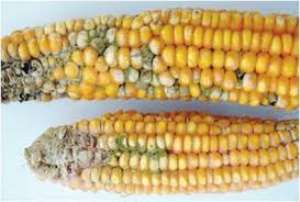
Accra, Sept. 2, GNA - The fight to control Afflation contamination of key staple foods in Ghana has been stepped up with the Agriculture ministry training its staff to pass on the knowledge to farmers.
Trained Staff of the ministry would be passing on information on Good Agricultural Practices (GAP) and Integrated Pest Management (IPM) to famers and other players in the agriculture value chain.
'These are good initiatives, which have helped farmers to improve food security and improve rural livelihoods by reducing crop losses to pest and diseases', said Mr Fred Asante of the Brong Ahafo Regional Office of the Plant Protection and Regulatory Services of the Ministry
Mr Asante made this known at a workshop attended by smallholder farmers, food sellers, agro processors and other players in the agriculture value chain in Techiman, in the Brong Ahafo Region.
He said the Ministry in collaboration with Plantwise/CABI has set up Plant Health Clinics in Asunafo North, Dormaa Municipality, Kintampo Municipality, Tano North and South districts and Techiman Municipality.
The workshop was organised by ECASARD, in collaboration with SEND-GHANA, with funding from the Southern Africa Trust, under a project dubbed 'Deepening linkages between Research, Advocacy and Media practitioners in Ghana for greater policy influence and impact II'
Dr. King David Amoah, the National Coordinator of ECASARD, the advocacy partners for the project noted that millions of people living in the country consume high and unsafe levels of Aflatoxin through their diets on a daily basis and that posed adverse health and economic effects along the food production and supply value chain.
This undermines efforts to improve nutrition, enhance agricultural production and minimizes economic gains from agricultural products, especially for small scale farmers.
'Inadequate pre and post-harvest management practices among small-holder farmers lead to the high and unacceptable levels of mycotoxins in maize and contribute greatly to the high statistics of stunted growth in children under five', said Daniel Adotey, a Programme Officer at SEND-GHANA, the project lead organization.
Notwithstanding the facts about the destructive nature of the fungus, Aflatoxins have not attracted much attention from policy makers in Ghana due to lack of targeted advocacy and public awareness, he said.
Whiles commending the Ministry of Food and Agriculture for the efforts made so far, he called for a multi-sectoral and multi-faceted approach for efficient monitoring, surveillance and cost-effective measures for control and prevention of aflatoxins contamination in food and feed products along the value chain in Ghana.
Brong Ahafo Region, a major maize producing region in Ghana is one of the hotspots of aflatoxin contamination as it has all the right conditions that the natural occurring fungi that produce aflatoxins thrive in.
This has led to the destruction of hundreds of bags of grains to the dismay of resource poor and also often, food insecure small-holder farmers leading to huge losses of much-needed income and food, and trade and health consequences.
Ghana has prioritized the realization of the Millennium Development Goals, reducing by half the number of people suffering from hunger by the year 2015.
While this effort requires a significant increase in the production and quality of food, food safety issues resulting from aflatoxin contamination, present a number of formidable challenges.
Aflatoxins are toxic metabolites produced by fungal species during their growth under favorable conditions of temperature and moisture.
The main cereals affected are maize, sorghum, rice and wheat and other crops like groundnuts and cassava.
Agricultural products contaminated with aflatoxins pose a major threat to human and animal health. Aflatoxin-contaminated agricultural products have a relatively low market value and are sometimes destroyed depending on the levels of contamination.
GNA




 Tuesday’s downpour destroys ceiling of Circuit Court '8' in Accra
Tuesday’s downpour destroys ceiling of Circuit Court '8' in Accra
 SOEs shouldn't compromise on ethical standards, accountability – Akufo-Addo
SOEs shouldn't compromise on ethical standards, accountability – Akufo-Addo
 Father of 2-year-old boy attacked by dog appeals for financial support
Father of 2-year-old boy attacked by dog appeals for financial support
 Jubilee House National Security Operative allegedly swindles businessman over sa...
Jubilee House National Security Operative allegedly swindles businessman over sa...
 Nobody can order dumsor timetable except Energy Minister – Osafo-Maafo
Nobody can order dumsor timetable except Energy Minister – Osafo-Maafo
 Mahama wishes National Chief Imam as he clock 105 years today
Mahama wishes National Chief Imam as he clock 105 years today
 J.B.Danquah Adu’s murder trial: Case adjourned to April 29
J.B.Danquah Adu’s murder trial: Case adjourned to April 29
 High Court issues arrest warrant for former MASLOC Boss
High Court issues arrest warrant for former MASLOC Boss
 Align academic curriculum with industry needs — Stanbic Bank Ghana CEO advocates
Align academic curriculum with industry needs — Stanbic Bank Ghana CEO advocates
 Election 2024: We'll declare the results and let Ghanaians know we've won - Manh...
Election 2024: We'll declare the results and let Ghanaians know we've won - Manh...
